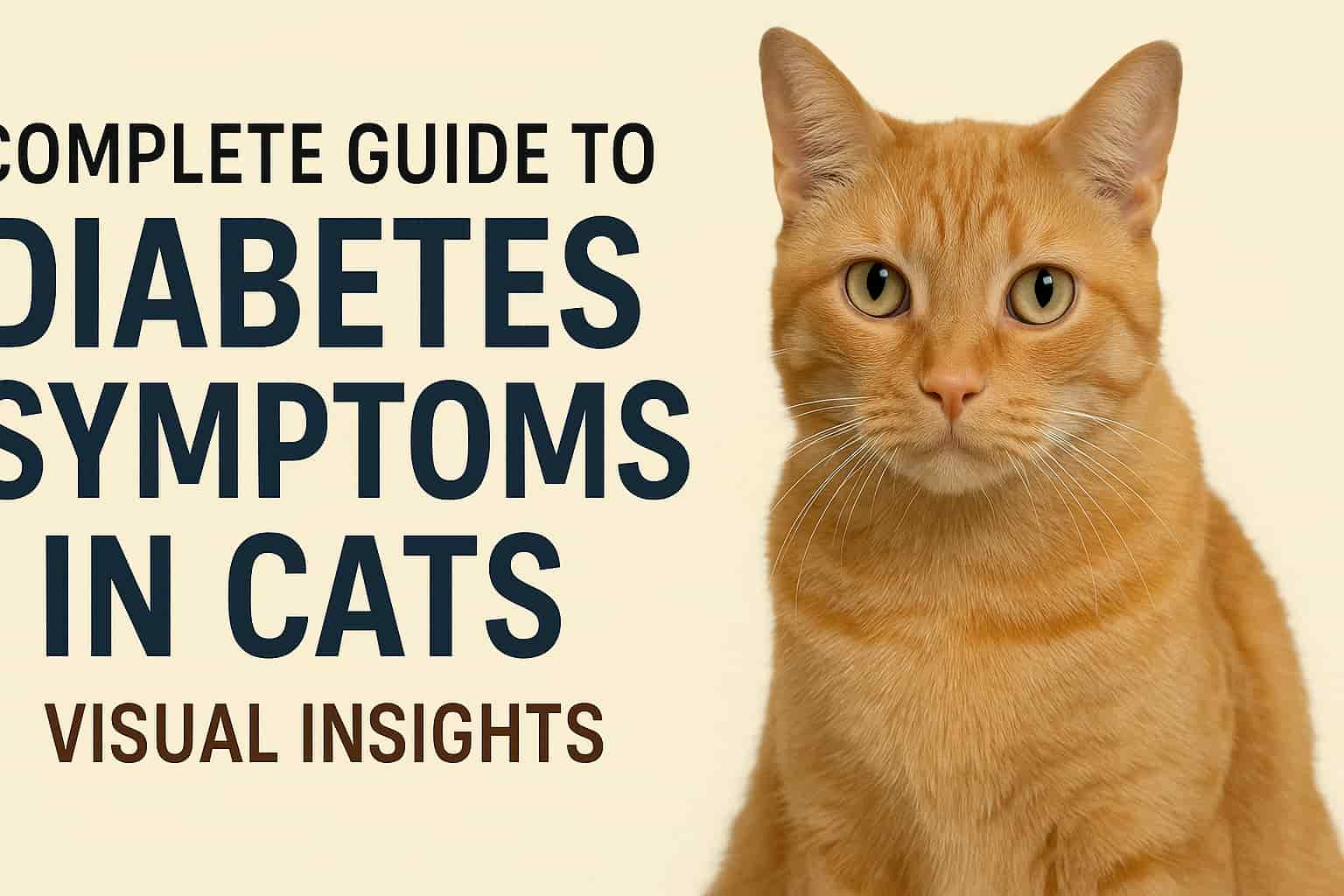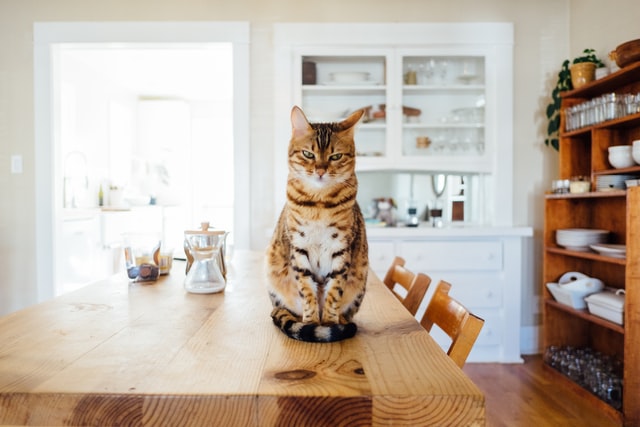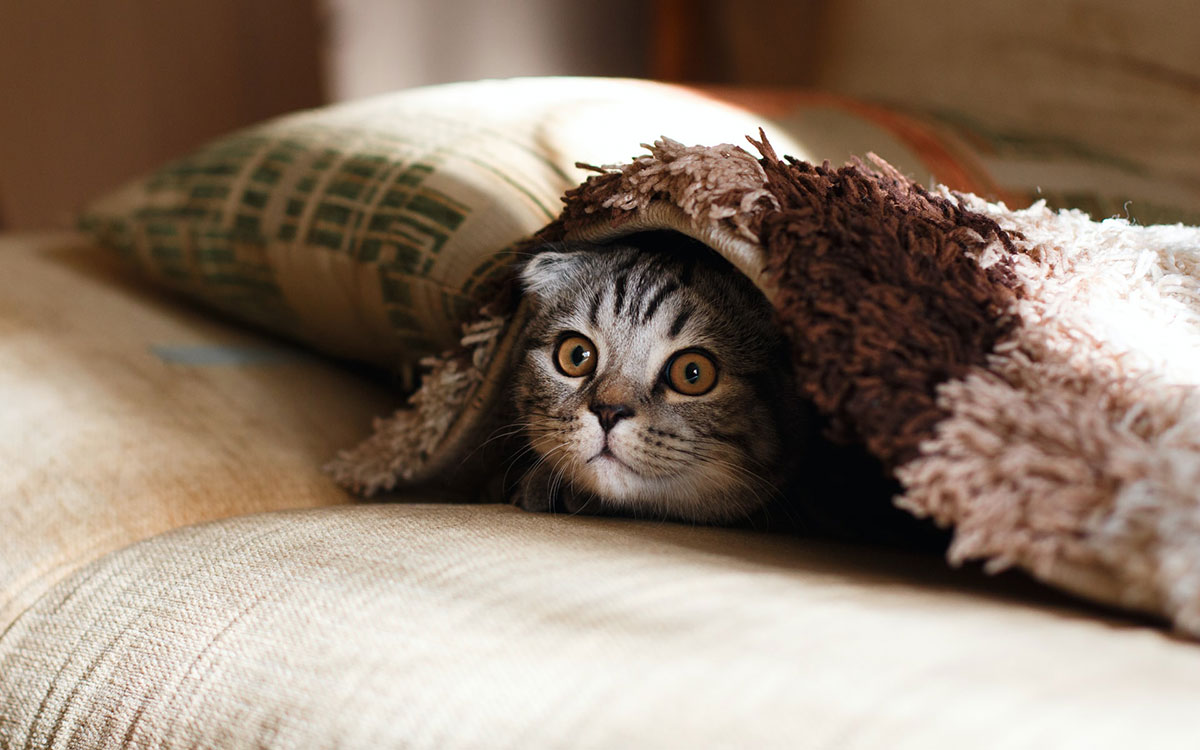Cats can develop diabetes, just like humans. Recognizing symptoms early is crucial.
This guide will help you understand what to look for in your feline friend. Diabetes in cats often goes unnoticed until it’s severe. Many cat owners miss the signs because they are subtle. Changes in appetite, weight, and behavior can indicate a problem.
Understanding these symptoms can make a big difference. With timely intervention, cats can live healthier lives. This guide provides detailed insights into common symptoms. Photos explain each symptom for easy identification. You’ll learn how these signs manifest in everyday behaviors, empowering you to take action early. Stay informed and keep your cat healthy by recognizing diabetes symptoms promptly.
Introduction To Feline Diabetes
Feline diabetes is a growing concern among cat owners. Understanding this condition is crucial for your pet’s health. Cats with diabetes need special attention and care. This guide will help you recognize symptoms early. Identifying these signs can make a significant difference. Early detection is key to managing feline diabetes effectively.
What Is Feline Diabetes?
Feline diabetes occurs when a cat’s body can’t use insulin properly. Insulin is a hormone that helps control blood sugar levels. Without enough insulin, sugar builds up in the blood, leading to various health issues. Cats may experience weight loss, increased thirst, and frequent urination, which indicate an imbalance in blood sugar levels.
According to the Merck Veterinary Manual, feline diabetes (primarily Type II) results from insulin resistance and beta-cell dysfunction.
➤ Merck Vet Manual: Diabetes Mellitus in Cats
Prevalence In Cats
Diabetes is more common in older and overweight cats, and male cats are also at a higher risk. Studies show that about 1 in 230 cats may develop diabetes, and this number is increasing with time. Indoor cats with little exercise are especially vulnerable. Awareness of this prevalence helps in taking timely preventive measures.
Studies suggest that 0.43% of cats (about 1 in 230) are diagnosed with diabetes, with the incidence increasing in indoor and overweight cats.
➤ Reference: Prahl A, Guptill L, Glickman NW, Tetrick M, Glickman LT. Time trends and risk factors for diabetes mellitus in cats: Analysis of veterinary medical data. J Vet Intern Med. Link to abstract
Early Warning Signs
Identifying diabetes in cats early can prevent complications. Key symptoms include unusual thirst and frequent urination. A complete guide with photos aids in understanding the signs of diabetes in felines.
Spotting the early warning signs of diabetes in cats can be crucial for their health and well-being. Cats are masters at hiding discomfort, so you must be extra vigilant. Recognizing these signs early can lead to better management and a happier life for your feline friend. But what should you look out for?
Polydipsia and polyuria are hallmark signs of diabetes in cats. According to the American Animal Hospital Association (AAHA), these symptoms are among the most reported by cat owners.
➤ AAHA Diabetes Guidelines
Increased Thirst
Have you noticed your cat drinking more water than usual? It could be one of the first signs of diabetes. Increased thirst, known as polydipsia, happens because your cat’s body is trying to flush out excess glucose. Imagine having to refill their water bowl more often, or spotting your cat hovering around the tap. It’s not just a quirky behavior; it’s a signal that something might be off. Keep track of how much water your cat consumes daily. Does it seem like an unusual amount for them? If yes, it’s time to take note and consult your vet. Increased thirst can sometimes be confused with other conditions, so it’s crucial to consider it alongside other symptoms.
Frequent Urination
Alongside increased thirst, frequent urination often appears as an early diabetes symptom. Pay attention if you’re cleaning the litter box more often or notice larger urine clumps. Frequent urination, or polyuria, is your cat’s response to drinking more. It’s their body’s way of getting rid of the extra sugar in the blood. Think about your daily routine: Has your litter box maintenance suddenly become more demanding? That isn’t just inconvenient; it’s a telltale sign that something might be wrong. Noticing this pattern can be a lifesaver, prompting you to seek veterinary advice sooner rather than later. Have you experienced a similar scenario with your pet, where early signs seemed innocuous? Don’t dismiss these changes as mere quirks. Your awareness and action can significantly impact your cat’s life.
Physical Changes In Diabetic Cats
Cats diagnosed with diabetes often show noticeable physical changes, which can signal a decline in their health. Regular observation is crucial for early detection. Understanding these signs helps manage your cat’s condition better. Below, we explore key physical changes in diabetic cats.
Weight Loss
Diabetic cats might lose weight rapidly, even if they eat normally. Insufficient insulin disrupts glucose absorption, so the body uses fat and muscle for energy, leading to noticeable weight loss. Monitor your cat’s weight regularly. Sudden changes can indicate diabetes.
Lethargy And Weakness
Weakness is a common symptom in diabetic cats. They may seem unusually tired. Low energy levels can affect their daily activities. Insufficient glucose in cells causes lethargy. Cats may prefer sleeping over playing. Watch for signs of decreased activity. It’s vital to keep them active and healthy.
Behavioral Indicators
Recognizing behavioral indicators of diabetes in cats can be crucial in managing their health effectively. Like humans, cats exhibit behavior changes when they’re not feeling their best. As a cat owner, you might notice subtle shifts in your feline friend’s habits. These changes often provide valuable clues about underlying health issues like diabetes. Understanding these behavioral signs ensures your cat gets the care they need promptly. You become their first line of defense.
Changes In Appetite
Is your cat suddenly more ravenous or disinterested in food? A significant shift in appetite can be a telltale sign of diabetes. Increased hunger might result from your cat’s body struggling to convert food into energy. Conversely, a loss of appetite might indicate nausea or discomfort. Keep an eye on their eating patterns and note any drastic changes. Sometimes, a simple observation can lead to early diagnosis and treatment.
Unusual Grooming Habits
Have you noticed your cat grooming more or less than usual? Diabetes can affect a cat’s grooming habits. Excessive grooming might be an attempt to soothe irritation or discomfort. Conversely, if your cat neglects their grooming routine, it might be due to lethargy or weakness. You should regularly groom your cat to maintain health and monitor deviations from normal behavior. You might find that their coat appears dull or unkempt, which can be another indicator.
Understanding these behavioral changes can be a lifesaver. Ask yourself: Is your cat behaving differently? Has there been a shift in their daily routine? These questions might lead you to discover more about your cat’s health. You can ensure your furry friend enjoys a healthy, happy life by staying vigilant.
Visual Diagnosis Techniques
Understanding diabetes symptoms in cats requires keen observation. Visual diagnosis techniques help identify issues early. These techniques focus on physical and behavioral changes. Observing your cat closely can reveal essential signs. Early detection allows for timely treatment, improving your cat’s health.
Observing Physical Symptoms
Physical symptoms can be visible with careful observation. Weight loss is a common sign. Even if your cat eats well, its weight can drop. Check for excessive thirst. Cats with diabetes often drink more water. Increased urination is another symptom. Watch for increased litter box usage. Look for a dull coat. A healthy cat has a shiny, smooth coat. If the coat appears dull or greasy, it may indicate a problem.
Monitoring Behavioral Changes
Behavioral changes can signal diabetes. Lethargy is a key indicator. A normally active cat may seem tired. Watch for changes in appetite. Some cats eat more; others lose interest in food. Increased vocalization can indicate discomfort. If your cat meows more often, it might be in pain. Changes in movement are also telling. Cats may walk differently if in discomfort. These changes, while subtle, are essential.

Importance Of Early Detection
Detecting diabetes in cats early can significantly affect your feline friend’s health. The sooner you identify the symptoms, the better you can manage the condition and avoid complications. Like humans, cats benefit from prompt medical attention, which can drastically improve their quality of life. Have you ever noticed subtle changes in your cat’s behavior that made you wonder if something was wrong? Recognizing these signs early could be the key to ensuring your cat’s long-term health and happiness.
Preventing Complications
Early detection helps in preventing serious complications such as nerve damage or infections. As diabetes progresses, these risks increase, making it harder for your cat to recover. Imagine if your cat’s diabetes went unnoticed until it was too late. Regular vet visits and keen observation can help you catch the condition before it spirals into severe health issues.
Consider setting reminders for regular vet check-ups. These visits can reveal hidden symptoms and allow for timely interventions. By catching the disease early, you can avoid costly treatments and prolonged discomfort for your cat.
Improving Quality Of Life
Timely diagnosis can significantly enhance your cat’s quality of life. Cats with managed diabetes can live comfortably and remain active. Early treatment allows you to tailor your cat’s diet and lifestyle to suit their needs, making everyday life easier for both of you.
Reflect on how a healthy routine impacts your life. It’s similar for your cat; a balanced diet and regular exercise can make a difference. Could adjusting your cat’s meals and playtime be the secret to their happiness?
Understanding the importance of early detection and acting promptly is a step toward ensuring your beloved pet’s well-being. By being proactive, you safeguard your cat from complications and enrich their life with comfort and joy.
Treatment Options For Diabetic Cats
Treating diabetes in cats requires a comprehensive approach. A veterinarian can help tailor a plan for your feline friend. This plan often includes diet changes and medication. Understanding these options can improve your cat’s quality of life.
Insulin therapy remains the most effective treatment, especially long-acting insulins like glargine.
➤ Roomp & Rand (2009), Management of diabetic cats with glargine and low-carb diets, Journal of Feline Medicine and Surgery. Read abstract
Diets low in carbohydrates are essential for glucose control.
➤ Backus RC et al. (2010). Low carbohydrate diet improves glycemic control in diabetic cats. Link
Diet And Lifestyle Modifications
A balanced diet is crucial for diabetic cats. Low-carbohydrate foods help maintain stable blood sugar levels, while high-protein diets support overall health and energy. Regular exercise can also aid in weight management, as obesity increases diabetes complications.
Monitor your cat’s food intake. Consistent feeding schedules help regulate blood sugar. Fresh water should always be available. Hydration supports kidney function. Consult your vet about specific dietary needs.
Medication And Insulin Therapy
Medication plays a vital role in treatment. The vet might prescribe oral medications. They help control blood sugar. Insulin injections are often necessary. Your vet will guide you through the process. Proper administration ensures effective treatment.
Regular vet visits are essential. Blood tests monitor your cat’s response. Adjustments to insulin dosage might be needed. Always follow your vet’s instructions. That ensures the best care for your pet.
Long-term Care Strategies
Explore vivid photos of diabetes symptoms in cats to understand long-term care strategies. Learn to recognize signs early. Implement effective care to ensure a healthy life for your feline friend.
Managing diabetes in cats involves more than just medication and diet. Long-term care strategies are crucial to maintaining your feline friend’s health and quality of life. Implementing these strategies helps manage the condition and strengthens the bond between you and your cat. So, what does effective long-term care look like?
Regular Veterinary Check-ups
Visiting the vet regularly is essential. These check-ups help you keep track of your cat’s progress and make necessary adjustments to their treatment plan. A typical check-up might include a blood glucose test and a discussion of any changes in behavior or appetite. Your vet can spot early signs of complications before they become serious. This proactive approach saves time, money, and stress for both you and your cat. Have you scheduled your next vet appointment yet?
Home Monitoring Tips
Monitoring your cat’s health at home is a game-changer. Start by keeping a daily log of their eating habits, insulin shots, and glucose levels. This information is invaluable during vet visits. Consider using a pet glucose meter for more accurate readings. It’s easy to use and provides instant feedback, helping you make quick decisions when necessary. Have you explored how this simple tool can improve your cat’s care? Observing your cat’s behavior is equally important. Changes in energy levels or water consumption can indicate shifts in their condition. Stay alert, and don’t hesitate to consult your vet if something feels off. Incorporating these strategies into your routine can make a significant difference in your cat’s well-being. Managing diabetes is a journey, but you can navigate it successfully with the right tools and a proactive mindset.
Frequently Asked Questions
What Are Some of The First Signs Of Diabetes In Cats?
Increased thirst and urination are among the first signs of diabetes in cats. These symptoms often lead to dehydration and weight loss. Regular vet check-ups help in early detection and management.
What Does A Diabetic Episode Look Like In A Cat?
A diabetic episode in a cat may show symptoms like increased thirst, frequent urination, weight loss, and lethargy. Cats might also exhibit poor appetite, vomiting, or weakness. Immediate veterinary attention is crucial if these symptoms appear, as untreated episodes can lead to severe complications.
How Do Cats Act When Their Sugar Is High?
Cats with high blood sugar may drink more water, urinate frequently, and appear lethargic. Increased hunger and weight loss can also occur. If you notice these symptoms, consult a veterinarian for proper diagnosis and treatment. Monitoring your cat’s behavior can help manage their health effectively.
Can I Check My Cat For Diabetes At Home?
You can check your cat for diabetes at home using glucose monitors. Consult your vet for accurate guidance. Regularly monitoring symptoms like increased thirst, urination, and weight loss can help. Perform testing carefully to ensure correct results.
Always seek professional advice for comprehensive care.
Conclusion
Recognizing diabetes symptoms in cats can protect their health. Early detection ensures timely treatment. Look for increased thirst, weight loss, and frequent urination. These signs might indicate diabetes. Regular vet check-ups help catch issues early. Maintain a balanced diet and healthy weight for your cat.
Always consult your vet for guidance. That ensures your cat’s well-being. Understanding these symptoms empowers pet owners. A little knowledge can make a big difference. Keep your feline friend happy and healthy. Stay informed and proactive in their care. Your cat depends on you for a healthy life.
References
Merck Veterinary Manual. Diabetes Mellitus in Cats. merckvetmanual.com
Prahl et al., Time trends and risk factors for diabetes mellitus in cats, JVIM, PubMed
Roomp & Rand. Glargine insulin and low-carb diets in feline diabetes, JFMS. PubMed
AAHA Guidelines on Diabetes Management. AAHA
Backus RC et al. Carbohydrate restriction improves glycemic control in cats. NCBI Article
🩺 Reviewed by Dr. Audrey Cook, BVM&S, MRCVS, DACVIM-SAIM, DECVIM-CA
Professor of Small Animal Internal Medicine
Texas A&M University, College of Veterinary Medicine & Biomedical Sciences
Dr. Audrey Cook is an internationally recognized veterinary endocrinologist with board certifications in both the United States and Europe. She specializes in small animal internal medicine, with a particular focus on feline diabetes, insulin therapy, and chronic disease management.
As a respected professor at Texas A&M University, Dr. Cook actively contributes to veterinary education, clinical research, and publishing peer-reviewed studies on feline endocrine disorders. Her expertise is widely sought at global veterinary conferences and by practicing veterinarians looking for advanced case insights.






